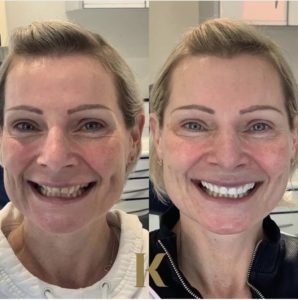Take a look at your smile.
Do you see any triangle-shaped gaps?
Black triangles between the teeth, also known as gingival embrasures, are pretty common in adults. In fact, according to a recent review, they occur in approximately 67% of people aged 20 and over. But not only do they look unattractive, they can have a significant negative impact on your overall oral health. And if you happen to spot them, it’s usually worth getting them sorted.
What causes black triangles between teeth?
Black triangle teeth can occur for many different reasons. Typically, the gaps appear because of oral health issues or your dental anatomy and some of the most common causes include:
-
Gum recession
Healthy gum tissue will hug your teeth; essentially, filling the gaps between them. But if this gum tissue starts to recede – perhaps due to your age, smoking habits, periodontal disease, or bone loss at the base of the tooth – this can expose the roots, creating dental black triangles.
-
Orthodontic treatment
Orthodontic dental procedures (e.g. braces) can sometimes lead to gingival embrasures. As the teeth are gradually moved into a new position, small gaps may start to appear at their roots. Some orthodontic appliances can also damage the gums, therefore adding to the issue.
-
Tooth shape
In many cases, black triangles are simply a result of the person’s natural tooth shape. Whilst some people have rectangular teeth (that are the same width at the gumline and biting point), others have triangular-shaped teeth, which are much narrower at the top than the bottom. And unfortunately, if this applies to you, you are automatically more susceptible to gingival embrasures.

Should I be concerned about black triangles?
Most people dislike their triangular-shaped gaps because of the way they look.
But it’s important to keep in mind, ‘black triangle teeth’ isn’t just a cosmetic issue. It’s very easy for food particles to get trapped and accumulate in the gap. And this can lead to a range of mild-severe dental issues, including plaque, cavities, tooth decay, gum disease and even dental abscesses.
That’s why, if you have black triangles between your teeth, it’s worth speaking to a dentist – to determine both why it has developed and what you can do to help.
How can I treat my black triangle teeth?
Several treatment options are currently available for black triangle teeth, including:
This is a minimally-invasive approach, in which composite resin is used to fill the dental black triangle. As the resin is matched to your natural tooth colour, it blends easily into your smile.
To hide the triangular-shaped gaps, and create a more even smile, porcelain veneers can be fitted to the surface of your tooth’s enamel. These are custom-made and designed to last a very long time.
Invisalign® can also work very well. By applying gentle pressure, the aligners move the teeth little by little, until a desirable position has been reached and the black triangles have been eliminated.
The right treatment for you will depend on both the severity and cause of your gingival embrasures. Therefore, the best option is to get in touch with our team of specialists – here at Kiln Lane Dental.
Not only can we offer tips on general oral hygiene, and the best ways to keep your black triangles clean, we can discuss the treatments available in detail and advise on the best one for your requirements. We currently offer all of the options outlined above (and more), and can create a bespoke treatment plan to tackle your dental black triangles and realise your dream smile.

So, why not get in touch?
If you’re suffering from black triangle teeth and would like to ‘mind the gap’, please feel free to give us a call on 01744 25776 and we will book you in for your consultation. Alternatively, you can send an email to info@kilnlanedental.co.uk and a member of the team will get back to you ASAP.